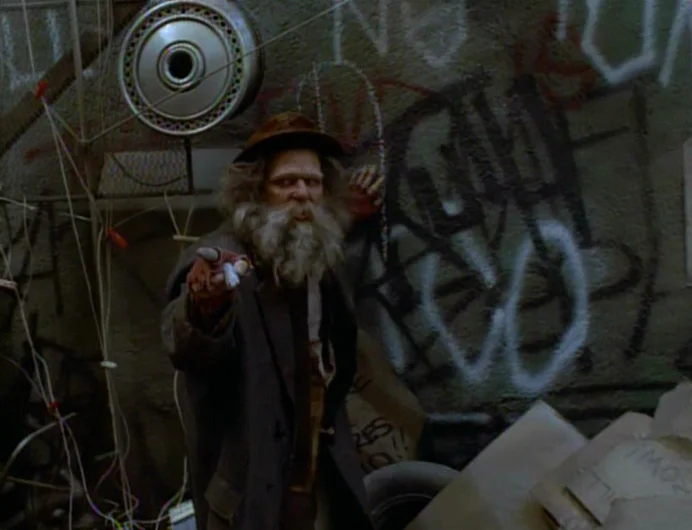by Lorrie Sears
The Doctor’s mobile emitter helped him break free from the confines of sickbay and the holodeck. Our intrepid Doctor, much to his chagrin, was a one-trick pony for most of the first two seasons of Voyager. Despite his first integration into the ship’s holodeck for the episode “Heroes and Demons,” and again merged with an alien technology to fight the diabolical clown in “The Thaw,” Doc mainly stayed in sickbay. His program, primarily a backup for his human counterpart who was killed in “Caretaker,” became an integral being on the ship. But, regardless of this fact, he could not leave his medical prison and take part in anything as simple as a staff meeting because of the lack of holo-emitters around the ship. His involvement in ship’s business grew over the first two seasons, starting with the simple task of giving soil samples to Kes and progressing to being kidnapped by Henry Starling in “Future’s End.” As time passed, the Doctor’s lack of mobility was becoming a more and more apparent limitation to his character.
Easy Come, Easy Go
The Doctor received his holoemitter thanks to Henry Starling, a 20th century computing pioneer using 29th century for his innovations.Henry Starling, the 20th century Star Trek equivalent of Steve Jobs and Donald Trump, had 29th century technology at his disposal after witnessing Captain Braxton’s time-traveling ship crash in the forest. When Harry tried to beam him onto Voyager to thwart his plan of going forward in time to steal more technology, he used this cutting-edge knowledge to scan Voyager’s 24th century database, stealing the Doctor’s program in the process. Starling gave Doc the innovative portable holo-emitter, effectively setting him free.
While solving one problem, it therein brings forth another. The Doctor, without the holo-emitter, can’t do much in regards to the plot unless the stories involve a holographic adventure or major medical emergency. Only the sick and infirmed would be privy to his opera singing and fine diplomatic skills. The audience’s view of fine performances such as in “Darkling” and “Living Witness” would not have happened without that emitter. So, this begs the question, why not use it? Answer: It’s an easy out for the writers.
Starting with the second-season episode “Persistence of Vision,” Torres and Kim were developing holo-emitter technology for key areas of the ship, such as the bridge. This idea was obviously never fully developed, because only in “Projections” does he exist on the bridge before he possessed the mobile emitter, and the events in that episode did not really occur.
In the episode “Basics, Part 1,” Torres installs mirrors along the hull of the ship, giving the appearance of an attack force of several ships by refracting holographic images. If such a feat was developed so quickly for the outside of the ship, why drop the idea of more holo-emitters inside the ship? This was never discussed, and the introduction of the mobile emitter alleviated the need to continue this storyline. For me, this is typical Voyager, magically receiving what’s needed when it’s needed. The tech solution of the week notwithstanding, this takes lazy writing to its limit. Instead of committing to a storyline that could have developed the Doctor’s character, and perhaps shown us some real ingenuity from Torres and Kim, the writers took the shortcut and dropped the solution in our laps, hoping we’d enjoy the “creative” solution to this problem.
“That’s the Paradox, My Dear”
Let’s step back a moment and examine another part of this issue from Captain Braxton’s perspective. Using a brick wall for a chalkboard, he would lecture us on the following: “A 20th century CEO gets possession of 29thcentury technology by way of a time ship crash, which plunges its captain back 900 years to the ‘barbaric’ world of Southern California in the late 1960s. Meanwhile, a 24th century starship, whose mere presence starts a causality loop, which threatens the existence of life as we know it now and the future of Starfleet, tries to destroy the time ship when the time ship tries to correct the problem, and exposes itself to 20th century humans in 1996, who believe it to be a UFO. Meanwhile, the 20th century CEO has been using the timeship’s technology for his own gain, while I, Captain Braxton, am forced to live on the streets and warn the primitive 20th century citizens of their impending doom. We all meet up in 1996 Los Angeles as a result of Janeway ignoring my request to destroy her BEFORE any of this madness happens. FOOLS!”
“That’s the paradox, my dear!”This loopy craziness only proved that this storyline was loaded with complicated ins and outs. In the process of setting things right and eventually venturing back to the Delta Quadrant, the Doctor ended up keeping his mobile emitter. Why does Captain Braxton allow this? He went all the way back to the 24th century to blow Voyager up, but he couldn’t go back to retrieve technology that, in reality, could and does alter the future (think “The Drone”)? Does Starfleet of the 29th century only allow one jump backwards to fix wrongs committed? The episode “Relativity” shows otherwise. Besides being the only episode to feature Seven in a Starfleet uniform, it demonstrated that time travel in the future can be repeated over and over again. No clear explanation is given as to why the Doctor was allowed to keep the mobile emitter, and this makes no sense. 29th century technology shouldn’t be allowed in the 24th century, especially with time cops keeping things in order…right?
Lazy Out or Worth It?
As a writer, I understand the need to move from point A to point B in a story. And, let’s face it: Anybody who watched the sardonic wit of the Doctor in the first few episodes of Voyager probably deduced that he would become one of the most popular characters on the show. Watching him and his acid-tongue bedside manner did not provide nearly enough screen time for his persona. He needed more. Weighing this against the argument that the mobile emitter was an easy out, I agree that the 29th century technology was well and appropriately used back on Voyager in the 24th century. The audience was not willing to wait for the installation of holo-emitters all over the ship, and neither was I. Despite some of the contradictions outlined previously, the ends justified the means. The Doctor – and Voyager – was better off for it.



